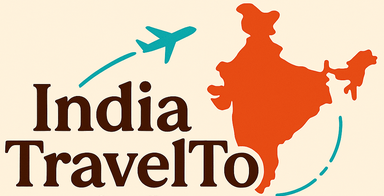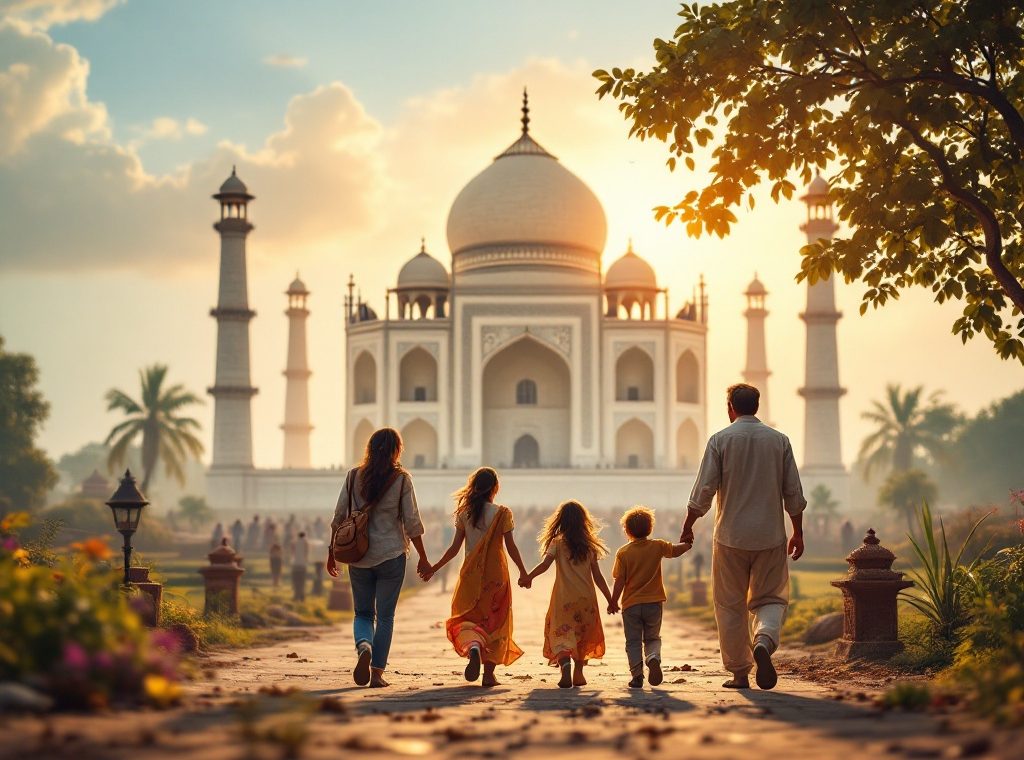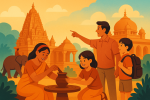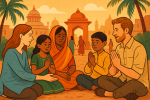India with Kids: Navigating Culture and Chaos on a Family Trip
Dreaming of an unforgettable family adventure? India awaits, offering captivating cultural experiences, breathtaking landscapes from the Himalayas to Goa’s beaches, and iconic landmarks like the Taj Mahal. Plan your family trip with our guide, covering visa requirements, kid-friendly destinations, health and safety tips, and insightful cultural advice. Discover how to navigate spicy cuisine, engage respectfully with local communities, and create lasting memories. Start planning your incredible Indian family journey today!
Important information
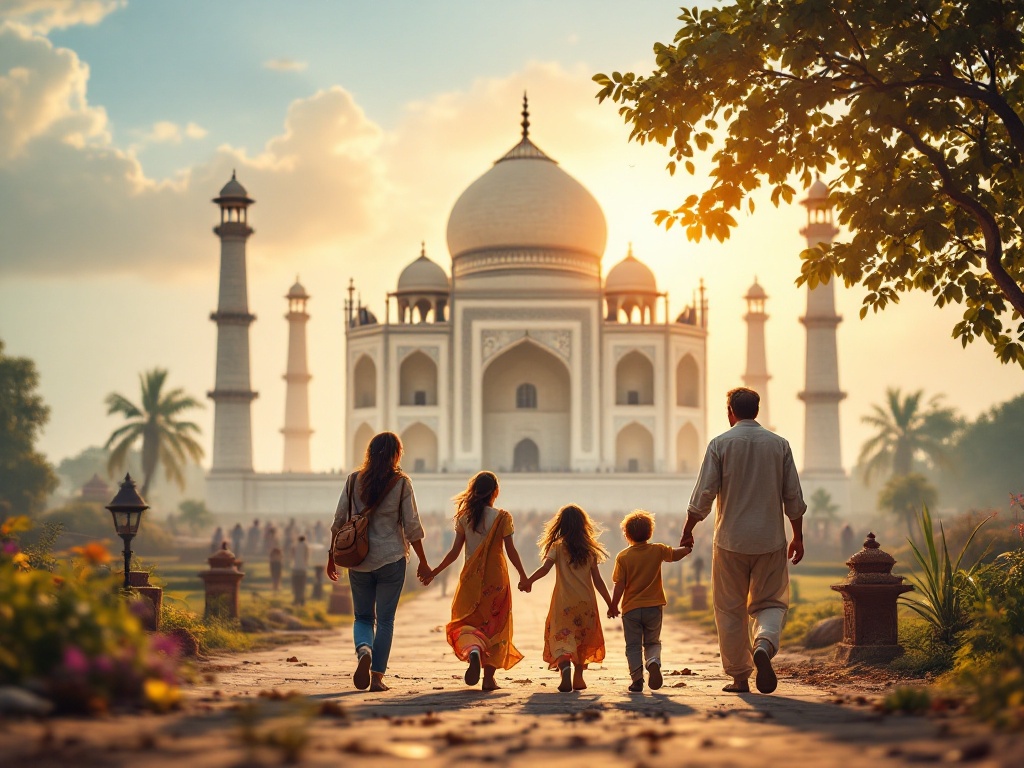
- Plan your trip during the cooler months (October to March) to avoid extreme heat and monsoons.
- Consult your doctor about recommended vaccinations (Hepatitis A and Typhoid) and necessary health precautions. Pack a first-aid kit.
- Prioritize family-friendly accommodations with amenities like breakfast and air conditioning. Check reviews and consider factors like location and safety. Book your first night in advance.
- Pack light, breathable clothing, closed-toe shoes, and modest attire for religious sites. Bring essentials like sunscreen, insect repellent, hand sanitizer, refillable water bottles with filters, and any necessary medications.
- Be flexible with your itinerary, as delays are common. Schedule downtime for rest and relaxation, especially for children.
Introduction to Family Travel in India
India is a fantastic destination for family adventures, offering diverse landscapes, rich culture, and incredible cuisine. This captivating country provides unique learning opportunities for all ages, making a trip with children especially rewarding. Families can share experiences like exploring ancient forts, wandering through bustling markets, and finding serenity in ancient temples. Planning is crucial for a smooth trip. Researching kid-friendly destinations and packing appropriately for the varying climates are essential for a truly enjoyable family adventure.
Planning your family adventure in India
Embark on a journey filled with ancient wonders, vibrant cultures, and breathtaking landscapes. Explore the majestic forts and palaces that whisper tales of emperors and dynasties. Wander through bustling markets, a sensory feast of colors, aromas, and sounds. Discover the serenity of ancient temples, where spirituality and history intertwine.
Making it smooth and enjoyable
Careful planning is key to a stress-free family adventure. Research kid-friendly destinations and activities to ensure everyone has a memorable experience. Pack smart, considering the diverse climates of India, from the Himalayan mountains to the tropical beaches. Be prepared for a journey that will enrich your family with unforgettable memories.
Step 1: Research destinations.
Explore various regions and identify kid-friendly locations. Consider factors like accessibility, safety, and availability of child-friendly facilities.
Step 2: Pack appropriately.
India’s climate varies significantly. Pack light, versatile clothing suitable for different weather conditions. Don’t forget essentials like sunscreen, insect repellent, and any necessary medications.
Step 3: Plan activities.
Choose activities that cater to different age groups and interests. Consider visiting national parks, wildlife sanctuaries, or engaging in cultural experiences like traditional dance performances.
Why Choose India for a Family Adventure?
India is a fantastic destination for families, brimming with culture, history, and stunning scenery. Kids will find it particularly captivating, with experiences ranging from exploring the magnificent Taj Mahal to witnessing the vibrant Holi festival.
Cultural Immersion
Engage with diverse communities and discover the rich tapestry of Indian traditions. Consider a hands-on cooking class where your children can learn the art of Indian cuisine.
Adventure and Exploration
Embark on a thrilling wildlife safari and witness India’s incredible biodiversity. From the Himalayas to Goa’s sunny beaches, India offers a diverse range of landscapes to explore.
Unique Perspectives: Traveling with Kids
A family trip to India creates unforgettable memories, especially for kids. Their fresh perspectives transform bustling streets and ancient landmarks into thrilling escapades. Imagine your children playing soccer with local kids, or the wonder of their first elephant ride. These are experiences that will stay with them forever. India presents a fascinating juxtaposition: opulent hotels stand in stark contrast to the vibrant tapestry of daily life, broadening young minds. While the kaleidoscope of sights, sounds, and smells can initially feel overwhelming, it becomes an integral part of the adventure, fostering curiosity, adaptability, and a deeper appreciation for the world’s rich diversity.
Planning Your Family Trip to India
Planning a memorable family trip to India begins with considering everyone’s ages and interests when choosing destinations. Think about what each family member would enjoy the most. Next, focus on essential logistics: visas, flights, and internal travel arrangements. Direct flights are often preferable for children, minimizing travel time, and e-visas are readily available online for many nationalities. However, it’s always wise to check specific visa requirements in advance.
Health and Safety
Consult your pediatrician regarding necessary vaccinations and pack a comprehensive first-aid kit. Travel insurance is also recommended to cover unforeseen emergencies, medical expenses, trip cancellations, or lost luggage. Ensure everyone in the family has adequate travel insurance coverage.
Accommodation
When choosing accommodations, prioritize family-friendly options like hotels or homestays with amenities such as breakfast and air conditioning. Look for accommodations that offer cribs, high chairs, or play areas if traveling with young children. Consider factors such as location, safety, and proximity to attractions when making your choice.
With thoughtful preparation, your Indian adventure will create lasting memories for the whole family. Remember to pack light, stay hydrated, and embrace the vibrant culture of India.
Choosing Family-Friendly Destinations
India is a fantastic destination for families, offering a variety of enriching experiences. Explore the tranquil backwaters of Kerala on a relaxing houseboat cruise from Kochi. Discover Kerala’s stunning beaches and vibrant wildlife sanctuaries. For a journey through history, visit Delhi, a city brimming with captivating historical sites. Seek a unique cultural immersion along the Ganges River in Varanasi. Experience the majestic forts of Jaipur. No family trip to India is complete without a visit to the iconic Taj Mahal in Agra.
Embark on a serene houseboat cruise along the backwaters of Kerala from Kochi.
Explore Kerala’s beautiful beaches and diverse wildlife sanctuaries.
Delve into history in Delhi, a city rich with captivating historical sites.
Immerse yourselves in the unique culture along the Ganges River in Varanasi.
Marvel at the majestic forts of Jaipur.
Conclude your family trip with an unforgettable visit to the iconic Taj Mahal in Agra.
Best Time to Visit: Avoiding the Monsoon Season
Plan your family trip to India during the cooler months from October to March to avoid the intense summer heat and monsoon rains. While the monsoon season (June to September) has its own charm, heavy rainfall and potential flooding could disrupt your travel plans. Visiting during the cooler months ensures a smoother and more enjoyable family experience.
Flights and E-Visa Requirements
For a smooth trip to India, fly direct to minimize travel time and jet lag, especially helpful for families with children. Apply for e-visas 4-30 days in advance. Remember that each child, like every adult, requires their own.
Travel Logistics and Practicalities
Traveling in India with your family offers diverse transportation options, including trains, planes, and private cars. Your choice depends on your budget and planned itinerary. Accommodation options range from comfortable hotels to immersive homestays, catering to various preferences. When packing for children, consider the weather and pack appropriate clothing. Remember essentials like toiletries and any necessary medications. Entertainment, such as books, games, or tablets, can keep children occupied during the journey.
Transportation
- trains,
- planes,
- private cars.
Accommodation
- comfortable hotels,
- immersive homestays.
When packing for children, consider the weather.
- clothes,
- toiletries,
- medications,
- entertainment (books, games, tablets).
Transportation: Trains, Flights, and Private Cars
Cars provide comfortable and flexible travel, a significant advantage considering the diverse conditions of Indian roads.
For covering vast distances quickly, air travel is the preferred option.
The extensive rail network offers scenic and comfortable long-distance journeys, especially in first-class or air-conditioned compartments.
Within cities, the ubiquitous auto-rickshaw is a popular choice for shorter trips.
Accommodations: Family-Friendly Hotels and Homestays
Plan your first night’s stay in advance for a hassle-free arrival. For families, hotels often offer rooms or suites designed specifically for their needs, sometimes with added benefits like kids’ clubs, babysitting services, and special menus. If you’re looking for a deeper cultural immersion, consider a homestay. This provides a unique opportunity to experience local traditions and connect with residents.Before booking, it’s wise to check reviews, especially from other families. Pay attention to essential amenities like breakfast and air conditioning. In India, it’s common for young children to share their parents’ bed without extra charges. This practice is widespread across the country.
Packing Essentials for Kids
Packing for your trip to India requires a balance of practicality and cultural sensitivity. Prioritize light, breathable clothing suitable for a warm climate. Dressing modestly with longer garments and a scarf is often appreciated, especially when visiting religious sites. Comfortable, closed-toe shoes are essential for navigating varied terrain. Pack a well-stocked first-aid kit with any necessary medications. For entertainment, bring favorite snacks, toys, and books. Hand sanitizer and refillable water bottles with filters will help maintain hygiene. Don’t forget a hat and sunglasses for sun protection. While packing extras is wise, remember that many items can be purchased locally. Packing cubes and backpacks are excellent for organization, and a laundry bag is always a handy addition.
Clothing
- Prioritize light, breathable fabrics suitable for a warm climate.
- Longer garments and a scarf demonstrate cultural sensitivity, especially at religious sites.
- Comfortable, closed-toe shoes are essential for varied terrain.
Essentials
- Pack a well-stocked first-aid kit and any necessary medications.
- Bring hand sanitizer and a refillable water bottle with a filter.
- Don’t forget a hat and sunglasses for sun protection.
Entertainment
Bring favorite snacks, toys, and books to stay entertained during your travels.
Organization
Packing cubes and backpacks are excellent for organization. A laundry bag is always a handy addition.
Remember, while packing extras is wise, many items are readily available for purchase in India.
Health and Safety Considerations
Stay healthy during your trip to India. Drink only bottled or sealed water, as tap water isn’t safe for consumption. Eat fruits and vegetables that you’ve peeled yourself. While quality medical care is accessible and affordable, travel insurance is always a good idea. Be cautious of potential dangers, such as children accidentally drinking pool water.
Vaccinations and Health Precautions
Consult your doctor about necessary vaccinations for your trip to India, such as hepatitis A and typhoid. Don’t forget to pack a first-aid kit and research local healthcare options in advance.
Food and Water Safety: Ensuring Health
Traveling with children requires careful attention to food and water safety. Here are some essential tips to ensure a healthy and enjoyable trip:
Always choose bottled or sealed water, even for brushing teeth. Opt for reputable restaurants known for their hygiene standards and order thoroughly cooked meals. Avoid raw foods, street vendor fare, and buffets where food sits out for extended periods.
Frequent handwashing is crucial, especially before meals and after using the restroom. Carry a reusable water bottle and refill it with purified water whenever possible. If your children have dietary restrictions or allergies, communicate these clearly to restaurant staff to avoid any mishaps.
Packing familiar snacks can be a lifesaver, ensuring your children have safe and enjoyable options readily available, especially if local options are limited or unfamiliar.
Dealing with Cultural Differences
Preparing your children for India’s vibrant culture will enrich their travel experience. Discussing local customs demonstrates respect and adds depth to their journey. For example, be aware that locals may want to photograph your children. Empower your kids to politely decline if they feel uncomfortable. A firm yet courteous “no” can often prevent misunderstandings. By understanding cultural nuances and establishing boundaries, you’ll equip your children to navigate such situations with confidence.
Cultural Sensitivity and Adaptability
Traveling with children to India? Instilling cultural sensitivity in your young travelers can enrich their experience. Here’s how:
Discuss appropriate attire.
Dress modestly, especially when visiting religious sites. Encourage girls to wear longer skirts or pants and cover their shoulders. Advise boys to avoid wearing shorts in temples. Remind children to remove their shoes before entering homes and temples, a sign of respect in Indian culture.
Encourage respectful interactions.
Teach children the traditional “Namaste” greeting. Learning basic Hindi phrases can also enhance communication and show appreciation for the local culture. Remind them to always ask permission before taking photos of people.
Promote cultural sensitivity.
Before and during your trip, discuss the importance of respecting local customs. Encourage observation and learning from the Indian people. Promote open-mindedness, curiosity, and a willingness to embrace the rich and diverse culture of India.
Respecting Local Customs and Dress Codes
When visiting India, dress respectfully, especially in rural areas and religious sites. Women often choose long skirts or pants and cover their shoulders, while men generally avoid shorts. Specific religious sites may have additional dress requirements. A simple “Namaste” is a customary greeting. Remember to remove your shoes before entering homes or temples as a sign of respect. Sharing these customs with children enriches their cultural understanding. Interacting with local families fosters a deeper appreciation of Indian traditions. Here’s a guide to Indian etiquette:
Dress Code: When visiting religious sites, dress modestly. Women should consider wearing long skirts or pants and covering their shoulders. Men should generally avoid shorts.
Greetings: A simple “Namaste” is a customary and respectful greeting in India.
Footwear: Remove your shoes before entering homes or temples as a sign of respect.
Cultural Exchange: Sharing these customs with children enriches their cultural understanding, and interacting with local families fosters a deeper appreciation of Indian traditions.
Encouraging Friendly Interactions
When kids connect, they build bridges between cultures. Shared games and conversations create lasting travel memories. Learning simple local greetings adds even more depth to these experiences. A small effort makes a big difference.
Teaching Kids Cultural Sensitivity
Preparing your children for a culturally enriching trip involves several key steps. Discuss the importance of respecting local customs, such as appropriate attire, particularly when visiting religious sites. Explain traditions like the “Namaste” greeting and removing shoes indoors, as these gestures demonstrate respect. Cultural sensitivity goes beyond basic etiquette.
Prepare your children for interactions with locals, including possible photo requests. Empowering them to politely decline uncomfortable situations teaches boundary-setting and respects local customs.
Sharing cultural stories enriches the travel experience. Encourage respectful curiosity about cultural differences and similarities, fostering empathy and understanding. This creates positive travel experiences for everyone involved.
Discuss appropriate attire, especially for religious sites.
Explain respectful gestures like “Namaste” and removing shoes indoors.
Prepare them for interactions with locals and teach them how to politely decline photo requests.
Share cultural stories and encourage respectful curiosity about cultural differences.
By preparing your children, you open their minds to a world of learning.
Engaging in Cultural Experiences
India offers incredible family experiences. Visiting landmarks like the Taj Mahal and Red Fort unlocks a captivating history, offering glimpses into India’s rich past. For a delicious cultural immersion, try a cooking class and explore the diverse spices and flavors of Indian cuisine. True cultural exchange blossoms through interactions with local communities: visit schools, attend events, and participate in craft workshops. These firsthand experiences foster understanding and appreciation for Indian traditions, creating lifelong memories that enrich family travel. Consider these options for an unforgettable family trip:
- Explore historical landmarks: Discover the majestic Taj Mahal, the imposing Red Fort, and other historical sites, immersing yourselves in India’s captivating past.
- Savor Indian cuisine: Take a cooking class and delve into the world of spices and flavors that make Indian food so unique.
- Engage with local communities: Visit local schools, participate in vibrant events, and learn traditional crafts in interactive workshops.
Visiting Iconic Landmarks
Family trips to iconic landmarks like the Taj Mahal, Red Fort, or Amer Fort create lasting memories. These destinations offer engaging activities where history and culture come to life through storytelling and interactive exhibits, making learning enjoyable and bringing the past to life for children.
Participating in Cooking Classes and Craft Workshops
Spice up your life with an Indian cooking class! Discover exotic ingredients and traditional techniques in a family-friendly environment where kids and adults can learn together. Explore Indian crafts through hands-on cultural workshops in pottery, weaving, or block printing.
Interacting with Local Villages and Communities
Experiencing Indian culture is best done by visiting local villages, where children can witness the lifestyle firsthand and create meaningful interactions.
Activities and Attractions for Kids
Experience India’s incredible wildlife. See tigers and elephants in Ranthambore and Kaziranga National Parks, offering unforgettable adventures.
Goa’s Beaches: Fun for the Whole Family
Goa’s beaches are perfect for family fun. Kids can swim, build sandcastles, and try exciting water sports. Explore local markets and savor delicious street food for a unique cultural immersion.
Many hotels offer kids’ clubs and play areas.
Kid-Friendly Attractions Across India
India offers a wealth of kid-friendly attractions. These range from theme parks and water parks to entertainment centers and science museums. Explore the cosmos in planetariums or step back in time at historical sites like the Taj Mahal and Red Fort.
Create lasting memories by interacting with local children and participating in cultural events.
Wildlife Adventures and Natural Wonders
Experience the wonders of India, from thrilling wildlife safaris to immersive cultural encounters. Spot tigers and elephants in renowned sanctuaries and national parks. Explore interactive museums and science centers in bustling cities like Mumbai and Delhi. Discover India’s rich history at iconic sites such as the Taj Mahal and the magnificent palaces of Jaipur, some featuring captivating light and sound shows. Connect with the vibrant culture through local cooking classes or craft workshops.
Relaxation and Play: Beaches and More
Goa and Kerala’s beaches are fantastic for children, offering ample space to swim and play. Families can unwind and enjoy the tranquil atmosphere. For those seeking more excitement, water and amusement parks provide thrilling alternatives for a different kind of family fun.
Local Activities and Kid-Friendly Attractions
Experience India’s rich history and diverse attractions. Explore the majestic Taj Mahal and the opulent palaces of Jaipur, many featuring captivating light and sound shows. Interactive museums and science centers in major cities provide enriching and entertaining experiences for all ages. Embark on a safari through India’s national parks to witness elephants and tigers in their natural habitat. Immerse yourself in Indian culture with hands-on cooking classes and craft workshops, learning traditional culinary skills or creating local handicrafts. Seek thrills at exciting theme parks or enjoy nostalgic fun at vintage playgrounds. Unforgettable wildlife encounters and exhilarating water sports add to the adventure. India truly offers something for every traveler.
Food and Dining with Kids
Indian cuisine is known for its vibrant spices, but families can always request milder versions. Many restaurants cater to younger palates with kid-friendly options like the ever-popular butter chicken and naan. India also boasts a rich variety of vegetarian dishes, including the staple lentil soup, dahl. Rice and an array of breads complement these meals and often suit vegan diets as well.
For those seeking familiar flavors, restaurants in tourist areas frequently offer international dishes such as pizza.
Supplementing meals with snacks from home or exploring local treats like roti and samosas can be a delightful experience, especially for children. Fresh, peeled fruit provides a healthy alternative, but exercise caution with street food.
Navigating Spicy Indian Cuisine
Introducing Indian cuisine to children can be an adventure, but the vibrant spices can sometimes be overwhelming for younger palates. Here’s how to ensure enjoyable mealtimes for the whole family:
Tips for Parents
- Request mild or spice-free versions of dishes.
- Gradually introduce milder Indian dishes to help children acclimate to new flavors.
- Combine familiar foods with local specialties.
Kid-Friendly Options
- Plain rice.
- Naan bread.
- Omelets.
- Fresh fruit (bananas, oranges).
Tourist areas often offer familiar favorites like pizza and fries.
Vegan and Vegetarian Options
India is a haven for vegetarian and vegan diners. Many restaurants clearly label these options. Traditional Indian cuisine offers a variety of lentil-based dals, vegetable curries, and rice dishes. Street food also presents delicious vegetarian and vegan choices, such as samosas and pakoras. Always confirm ingredients with vendors to ensure your dietary needs are met. With veganism’s growing popularity, many Indian establishments now cater specifically to vegan diets.
Child-Friendly Menus and Local Snacks
Introducing your children to the diverse flavors of Indian cuisine can be a delightful experience. Indian restaurants are generally kid-friendly, often offering milder versions of their popular dishes. Excellent choices include butter chicken, naan, and plain rice. Many restaurants, especially in tourist areas, also provide international favorites like pizza and pasta. Simple snacks such as fresh bananas and mangoes are a great way to supplement meals, especially for picky eaters. Pre-packed snacks can also be helpful. Bustling local favorites are ideal for their fresh food and quick service. To ensure your child enjoys their meal, simply request dishes without spices or added salt.
Maximizing Your Family Adventure
Planning a family trip to India? Be prepared for an adventure filled with exciting and unexpected moments. Flexibility is key when traveling in India, as delays and changes in plans are common. Build buffer time into your itinerary to accommodate any unforeseen circumstances. Remember that downtime is essential, especially for younger children. Schedule breaks throughout your trip to allow everyone to rest and recharge. While India offers a plethora of experiences, avoid over-scheduling. A packed itinerary can lead to exhaustion, diminishing the enjoyment of your trip.
Travel Hacks for a Smoother Trip
- Pre-book train tickets to avoid last-minute hassles.
- Carry a portable charger to ensure your devices are always powered up.
- Pack a basic first-aid kit with essentials like bandages, antiseptic wipes, and pain relievers.
- Stay hydrated by drinking plenty of bottled water.
- Research reliable transportation options in advance.
Respecting Local Customs
Engage with locals respectfully and be mindful of cultural norms. Embrace the unexpected and enjoy the unique experiences that India has to offer. India is a land of surprises, so be open to new adventures and create lasting memories with your family.
Flexibility and Adaptability in Travel Plans
Family adventures in India are best experienced with flexibility. Unexpected situations are common, so be prepared to adjust your plans. Children, in particular, may become tired or overwhelmed, making downtime essential. A flexible itinerary allows for rest and relaxation, accommodating these shifts. A positive and patient attitude is also key to navigating India’s unique challenges. Embrace the unexpected to minimize stress and maximize enjoyment, creating lasting family memories.
Including Downtime for Rest and Recharge
Travel downtime is essential for recharging kids’ batteries. Quiet activities, like reading or simply relaxing at the hotel, can prevent exhaustion and make the trip more enjoyable for everyone. Scheduling these breaks is key to a smoother, happier travel experience.
Travel Hacks and Safety Tips for Families
Smart travel begins with packing light for easier mobility. Booking flights and accommodations in advance secures the best deals. Leverage travel apps for navigation and translation—they’re invaluable tools.
Safety and Health
Prioritize safety by securing important documents and staying aware of your surroundings. Vigilance is crucial. Share your itinerary with someone you trust.
Health Precautions
Consult a travel doctor before departure for personalized health advice and necessary precautions. Incorporate flexibility into your itinerary to accommodate unexpected delays and inevitable changes.
